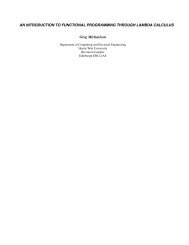- Page 8 and 9: AMATH 581 ( c○J. N. Kutz) 9is O(
- Page 10 and 11: AMATH 581 ( c○J. N. Kutz) 11Upon
- Page 12 and 13: AMATH 581 ( c○J. N. Kutz) 13We be
- Page 14 and 15: AMATH 581 ( c○J. N. Kutz) 15This
- Page 16 and 17: AMATH 581 ( c○J. N. Kutz) 17Figur
- Page 18 and 19: AMATH 581 ( c○J. N. Kutz) 19y’
- Page 22 and 23: AMATH 581 ( c○J. N. Kutz) 23be th
- Page 24 and 25: AMATH 581 ( c○J. N. Kutz) 253. Th
- Page 26 and 27: AMATH 581 ( c○J. N. Kutz) 27break
- Page 28 and 29: AMATH 581 ( c○J. N. Kutz) 29O(∆
- Page 30 and 31: AMATH 581 ( c○J. N. Kutz) 31O(∆
- Page 32 and 33: AMATH 581 ( c○J. N. Kutz) 33slope
- Page 34 and 35: AMATH 581 ( c○J. N. Kutz) 35and
- Page 36 and 37: AMATH 581 ( c○J. N. Kutz) 37n=N+1
- Page 38 and 39: AMATH 581 ( c○J. N. Kutz) 39ωmnt
- Page 43 and 44: AMATH 581 ( c○J. N. Kutz) 44MATLA
- Page 45 and 46: AMATH 581 ( c○J. N. Kutz) 46k x k
- Page 47 and 48: AMATH 581 ( c○J. N. Kutz) 48k x k
- Page 49 and 50: AMATH 581 ( c○J. N. Kutz) 50the F
- Page 51 and 52: AMATH 581 ( c○J. N. Kutz) 52The r
- Page 53 and 54: AMATH 581 ( c○J. N. Kutz) 54u=exp
- Page 55 and 56: AMATH 581 ( c○J. N. Kutz) 56Figur
- Page 57 and 58: AMATH 581 ( c○J. N. Kutz) 58Strea
- Page 59 and 60: AMATH 581 ( c○J. N. Kutz) 60kx(1)
- Page 61 and 62: AMATH 581 ( c○J. N. Kutz) 623.1 B
- Page 63 and 64: AMATH 581 ( c○J. N. Kutz) 642D MA
- Page 65 and 66: AMATH 581 ( c○J. N. Kutz) 66ttj+1
- Page 67 and 68: AMATH 581 ( c○J. N. Kutz) 68tm+1u
- Page 69 and 70: AMATH 581 ( c○J. N. Kutz) 70Schem
- Page 71 and 72:
AMATH 581 ( c○J. N. Kutz) 72Forwa
- Page 73 and 74:
AMATH 581 ( c○J. N. Kutz) 74Leap-
- Page 75 and 76:
AMATH 581 ( c○J. N. Kutz) 76In th
- Page 77 and 78:
AMATH 581 ( c○J. N. Kutz) 783.5 O
- Page 79 and 80:
AMATH 581 ( c○J. N. Kutz) 80Figur
- Page 81 and 82:
AMATH 581 ( c○J. N. Kutz) 82Figur
- Page 83 and 84:
AMATH 581 ( c○J. N. Kutz) 84Figur
- Page 85 and 86:
AMATH 581 ( c○J. N. Kutz) 8610.50
- Page 87 and 88:
AMATH 581 ( c○J. N. Kutz) 88x 0x
- Page 89 and 90:
AMATH 581 ( c○J. N. Kutz) 901.0T
- Page 91 and 92:
AMATH 581 ( c○J. N. Kutz) 921x m=
- Page 93 and 94:
AMATH 581 ( c○J. N. Kutz) 94• F
- Page 95 and 96:
AMATH 581 ( c○J. N. Kutz) 96% w_y
- Page 97 and 98:
AMATH 581 ( c○J. N. Kutz) 98We no
- Page 99 and 100:
AMATH 581 ( c○J. N. Kutz) 100A. A
- Page 101 and 102:
AMATH 581 ( c○J. N. Kutz) 102yy1.
- Page 103 and 104:
AMATH 581 ( c○J. N. Kutz) 104wher
- Page 105 and 106:
AMATH 581 ( c○J. N. Kutz) 106Conn
- Page 107 and 108:
AMATH 581 ( c○J. N. Kutz) 108ydy/
- Page 109 and 110:
AMATH 581 ( c○J. N. Kutz) 110t=0
- Page 111 and 112:
AMATH 581 ( c○J. N. Kutz) 112This
- Page 113 and 114:
AMATH 581 ( c○J. N. Kutz) 114by i
- Page 115 and 116:
AMATH 581 ( c○J. N. Kutz) 116φ =
- Page 117 and 118:
AMATH 581 ( c○J. N. Kutz) 118wher
- Page 119 and 120:
AMATH 581 ( c○J. N. Kutz) 1205.2
- Page 121 and 122:
AMATH 581 ( c○J. N. Kutz) 122Thus
- Page 123 and 124:
AMATH 581 ( c○J. N. Kutz) 124wher
- Page 125 and 126:
AMATH 581 ( c○J. N. Kutz) 126z (w
- Page 127 and 128:
AMATH 581 ( c○J. N. Kutz) 128To s
- Page 129 and 130:
AMATH 581 ( c○J. N. Kutz) 1302. T
- Page 131 and 132:
AMATH 581 ( c○J. N. Kutz) 132∂v
- Page 133 and 134:
AMATH 581 ( c○J. N. Kutz) 134Figu
- Page 135 and 136:
AMATH 581 ( c○J. N. Kutz) 136z (w
- Page 137 and 138:
AMATH 581 ( c○J. N. Kutz) 138Figu
- Page 139:
AMATH 581 ( c○J. N. Kutz) 140boun
















